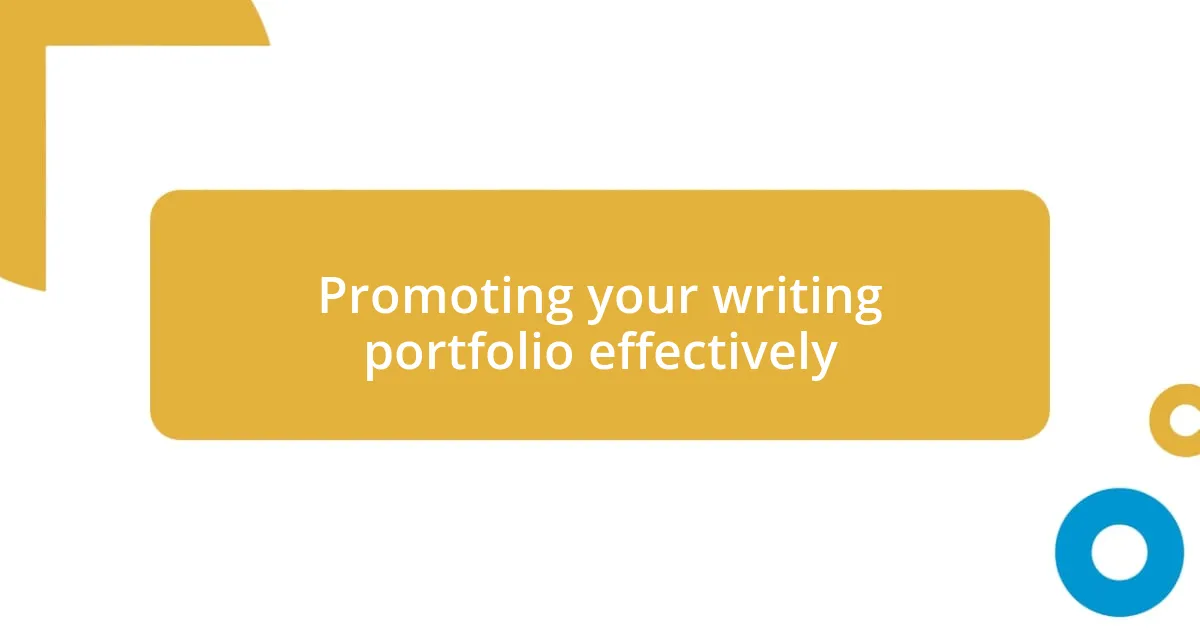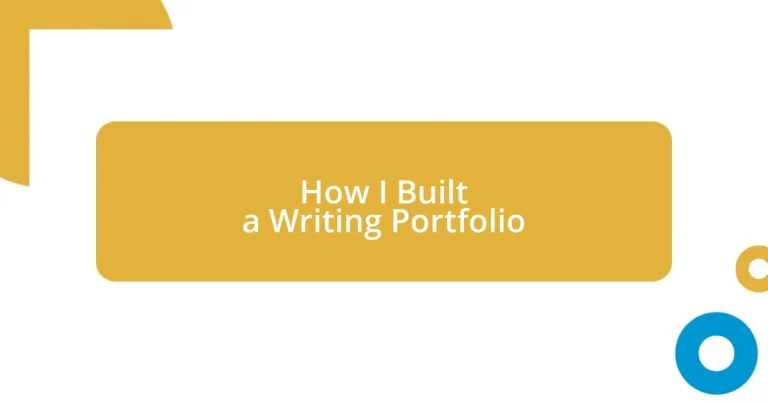Key takeaways:
- Identify and define your writing niche by reflecting on personal passions and experiences to create authentic, engaging content.
- Select quality writing samples that represent your voice, showcase versatility, and include personal connections to strengthen your portfolio.
- Utilize online platforms for creating a polished portfolio, leveraging analytics and social media for greater visibility and audience engagement.
- Regularly update your portfolio to reflect growth, remove outdated work, and maintain accurate details for a fresh, inviting presentation.

Defining your writing niche
Finding your writing niche can feel like searching for a hidden treasure. I remember when I first started writing; I tried my hand at everything from poetry to product descriptions. The moment I discovered my passion for travel writing, everything clicked—suddenly, I wasn’t just writing; I was sharing experiences and connecting with readers who shared my wanderlust.
When I think about defining a niche, I ask myself what topics ignite my passion and why. Is it the thrill of adventure? The allure of storytelling? It’s essential to consider what excites you because that enthusiasm will shine through in your writing, making it more engaging and authentic. I often find that reflecting on my personal interests helps me carve out a space where my voice resonates clearly.
Have you thought about what makes your writing unique? For me, it was the blend of personal experience and research that set my work apart. I started focusing on eco-tourism, blending my love for nature with storytelling. This alignment not only strengthened my portfolio but also attracted like-minded readers who appreciate a deeper narrative. What about you? What stories do you want to tell?

Gathering your best writing samples
When it comes to gathering your best writing samples, I believe it’s crucial to reflect on work that truly represents your voice and skills. I once found myself sifting through dozens of articles, unsure which ones highlighted my strengths. I realized it’s not just about quantity; it’s about quality. For instance, I chose pieces that sparked joy and resonated with my audience, showcasing a range of styles and themes that felt authentic to my journey as a writer.
To ensure I picked samples effectively, I kept the following criteria in mind:
- Passion: Select pieces you genuinely enjoyed writing.
- Engagement: Opt for work that received positive feedback from readers.
- Versatility: Include a variety of writing styles and topics to show your range.
- Professionalism: Choose polished and well-edited samples that reflect your best work.
- Personal Connection: Highlight work that tells a story or expresses a unique perspective.
By curating your samples thoughtfully, you not only create a portfolio that stands out but one that feels like a true representation of who you are as a writer.

Creating a professional portfolio layout
Creating a professional portfolio layout is an exciting journey that can showcase your creativity and expertise. I remember spending hours experimenting with different designs to find the perfect balance between aesthetics and functionality. It’s important to structure your portfolio in a way that allows readers to navigate easily while highlighting your best work. A clean layout that emphasizes clarity will keep your audience engaged and make a positive impression.
I learned that the arrangement of elements plays a significant role. For instance, using consistent fonts and colors helps create a cohesive look. Additionally, breaking down your content into sections—like ‘About Me’, ‘Writing Samples’, and ‘Contact Information’—ensures that visitors can find what they’re looking for without any hassle. Personal touches, such as including a friendly photo or a short bio, can also make the layout feel welcoming, inviting readers to connect with you on a more personal level.
To visualize the impact of various layout options, I found it helpful to compare them side by side. Below is a simple comparison table of different layout styles and their key attributes.
| Layout Type | Features |
|---|---|
| Grid Layout | Structured and neat, ideal for displaying multiple samples without clutter. |
| Single Column Layout | Focused and minimalistic, guides the reader’s attention to one piece at a time. |
| Interactive Layout | Engaging and dynamic, includes elements like videos or animations to showcase creativity. |

Utilizing online portfolio platforms
Utilizing online portfolio platforms can significantly streamline the process of showcasing your work. When I first explored these platforms, I was amazed at how user-friendly they can be. Websites like Wix and Squarespace offer intuitive design templates that cater to writers, making it easy for anyone, regardless of their tech-savviness, to create a professional-looking portfolio. Have you ever felt overwhelmed by design choices? I certainly did, but these platforms turned the daunting task of building my portfolio into a creative adventure.
One of the standout features I appreciated was the built-in analytics tools many platforms provide. Tracking how often my work was viewed allowed me to gain insights into what resonated with my audience. I remember the day I noticed a spike in traffic for a particular article of mine; it was such a boost to my confidence. Understanding audience engagement shaped my future writing direction. Isn’t it interesting how data can inform creativity while also serving as a source of motivation?
Furthermore, online portfolio platforms often allow for easy integration with social media, enhancing your visibility. I found that by sharing my portfolio link on platforms like LinkedIn and Twitter, I could reach a broader audience and even connect with potential clients. If you’re hesitant about stepping into the online space, remember that these platforms can not only showcase your work but also build a professional network that extends beyond traditional boundaries. How can you leverage that power in your own writing journey?

Promoting your writing portfolio effectively
Promoting your writing portfolio effectively can be a game-changer in your journey as a writer. My experience showed me that simply having a polished portfolio isn’t enough; I had to actively share it. I started by including my portfolio link in my email signature, which turned every correspondence into an opportunity for exposure. It’s a small yet impactful step—have you thought about how many potential connections you could reach through your everyday communication?
Social media has become a powerful ally for promoting my work. I remember the excitement when I shared snippets of my writing on Instagram, paired with eye-catching visuals. That post garnered more engagement than I anticipated and drove traffic to my portfolio. Utilizing hashtags relevant to my niche not only helped increase visibility but also connected me with a community of writers and readers who share similar interests. Have you tapped into the potential of social media in your strategy?
Lastly, networking both online and offline is essential. I made a point to participate in writing groups and workshops—these gatherings opened doors for collaboration and sharing my portfolio with like-minded individuals. The personal connections I formed often led to referrals and even potential clients. When was the last time you invested in a writing community? The relationships you build can be just as valuable as your portfolio itself.

Updating and maintaining your portfolio
Updating and maintaining your portfolio is vital for keeping it relevant and engaging. I vividly recall the moment I decided to refresh mine; I realized how much my writing style had evolved. Regularly adding new pieces helps reflect my growth and keeps potential clients interested. Have you ever considered how an outdated portfolio might affect the impression you make?
I recommend setting a schedule for yourself—maybe every few months—to review and update your work. When I did this, I found pieces I had forgotten about that showcased my best skills. Removing outdated or lower-quality work is just as important; I often think of it like curating a gallery. Are you ready to let go of pieces that no longer represent your current abilities?
Additionally, maintaining your portfolio goes beyond just adding new pieces. It’s also about ensuring that each entry has accurate details, such as publication dates and links. The pride I felt when I finally sorted out broken links was immense. It’s like maintaining a well-tended garden; regular upkeep keeps everything looking fresh and inviting. How often do you tend to your writing portfolio?














